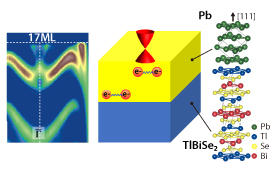

03/30/2020

Adapted from Ref. 1 and licensed under CC BY 4.0 © 2020 C. X. Trang et al.
A new way to make topological superconductors — promising materials for realizing robust quantum computers that are more tolerant of faults than existing technologies — has been discovered by AIMR researchers1. This method should make it possible to convert conventional superconductors into topological ones, greatly increasing the number of topological superconducting systems.
Superconductors can conduct electricity without resistance. A special class known as topological superconductors are superconducting everywhere except on their surfaces, where they conduct electricity with a low resistance, like metals do. They are exciting interest because they could host exotic quasiparticles known as Majorana fermions. Named after the Italian physicist who predicted their existence about 80 years ago, Majorana fermions are attractive for realizing fault-tolerant quantum computers. While they have yet to be definitively observed, there is mounting experimental evidence for their existence.
Until now, topological superconductors have generally been made by bringing a superconductor into contact with a topological insulator — a material that is electrically insulating internally but conductive on its surface. The superconductor imparts a thin portion of the topological insulator with superconductivity, an effect known as the superconducting proximity effect. But it is hard to detect Majorana fermions in such topological superconductors. “Since the superconducting proximity effect occurs at an interface far from the surface, it is generally difficult to probe Majorana fermions by surface spectroscopy techniques,” explains Takafumi Sato of the AIMR at Tohoku University.
Sato and co-workers have produced a topological superconductor by reversing the influence between the superconductor and the topological insulator — they transferred topological properties to a conventional superconductor. They did this by growing a thin film of superconducting lead on a topological insulator, which proved to be quite challenging. “Until our study, no-one had ever succeeded in fabricating a lead film on a topological insulator,” says Sato. “It was a big challenge and we had to optimize the growth conditions very carefully and fabricate more than 70 samples until we got one that was satisfactory.”
The team then performed spectroscopy measurements that strongly suggested that they had produced a topological superconductor.
The team’s method opens up the possibility of producing topological superconductors in a much wider range of systems than before. “Our concept may be widely applicable to other combinations of superconductors and topological insulators,” says Sato. “Exploring new material systems based on our idea, could accelerate investigations of topological superconductors and the detection of Majorana fermions and ultimately, their possible applications to quantum computation.”
This research highlight has been approved by the authors of the original article and all information and data contained within has been provided by said authors.